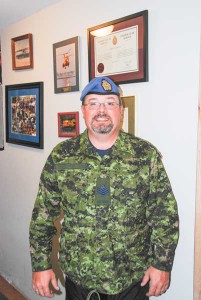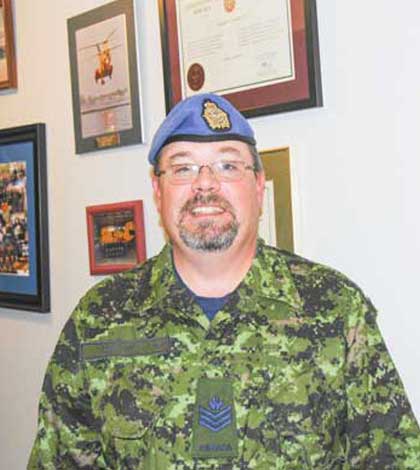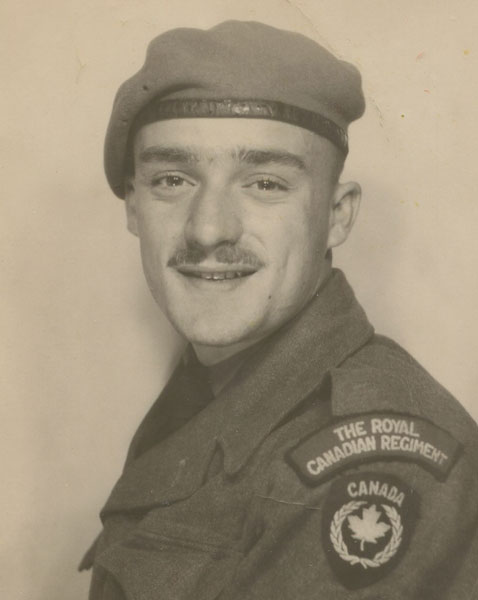 MANITOWANING—While much of The Expositor’s past Remembrance Day coverage has focussed on the veterans of the First and Second World Wars, it is important to realize that there are many more veterans who also walk among us, quiet in their pride of having served their country. One such veteran is Sgt. Trevor Leeson of Manitowaning, who recently retired after 24 years of service with the Canadian Air Force.
MANITOWANING—While much of The Expositor’s past Remembrance Day coverage has focussed on the veterans of the First and Second World Wars, it is important to realize that there are many more veterans who also walk among us, quiet in their pride of having served their country. One such veteran is Sgt. Trevor Leeson of Manitowaning, who recently retired after 24 years of service with the Canadian Air Force.
Not unlike those veterans of wars past, Sgt. Leeson enlisted at the tender age of 17 in 1988, requiring his mother Gail Leeson’s signature to do so, just two weeks shy of his graduation from Manitoulin Secondary School. Sgt. Leeson’s older brother Shane was also in the forces, a tank commander with the 8th Canadian Hussars at the time.
It was as a teenager in Little Current that Sgt. Leeson first fell in love with aircraft, recalling the Coast Guard’s big yellow Labrador helicopter coming to Little Current’s Spider Bay Marina, where his father Weston was the manager, and giving him the ride of a lifetime. The helicopter was involved with a search and rescue demonstration through the Little Current Volunteer Fire Department. It was also in 1988 that a Hercules aircraft made a visit to the grand opening of the Manitoulin-East Airport, another highlight for the impressionable youth.
“Shane,” he said, “helped mentor me and opened my eyes to a career in the Canadian Forces. If it wasn’t for him, I doubt my mother Gail would have signed my permission to join at the age of 17.”
It was also Shane who encouraged his younger brother to specialize, which he did, choosing to train as a performance-oriented electronic technician with the Air Force at the Canadian Forces School of Communications and Electronics at CFB Trenton following recruit school at CFB Cornwallis in Nova Scotia.
“I was the youngest guy wherever I went,” Sgt. Leeson laughed.
The teen excelled in training and made a point of furthering his education any chance he got.
The young recruit began by repairing aircraft electronic systems then moved on to the Canadian Forces School of Aerospace Technology and Engineering at CFB Borden.
“I didn’t realize when I joined how much training was involved—I trained until I was 19,” Sgt. Leeson explained.
“I wanted to start on the biggest aircraft I could—the Boeing 707 and the Hercules—and got my wish,” he smiled at the thought. “I was posted to CFB Trenton and from there, continued on to apprenticeship training, doing exactly what I wanted to do.” It was in Trenton where he met his wife Trish who is from that Lake Ontario community.
“I pretty much saw the world by the age of 20, ‘cause when an aircraft breaks, it breaks anywhere in the world,” he added.
It was while he was on leave in Germany, visiting his brother who was stationed there at the time, that he and his crew were called to be a part of Operation Friction and the Gulf War in 1989. Sgt. Leeson was also involved in supporting operations in the Balkan conflict, delivering food and medical supplies to Africa, with many stopovers in bases in Doha, Qatar, Aviano, Italy and CFB Lahr, West Germany.
By 1993, Sgt. Leeson was selected to take part in training when the 424 Search and Rescue Squadron received Hercules aircraft, cross training on Labrador and Voyageur helicopters. In 1996, the sergeant was then posted to the 103 Rescue Unit in Gander, Newfoundland, which later became the 103 SAR Squadron, thanks to a little help from the Queen’s representative for the event, Prince Phillip (whom Sgt. Leeson’s wife Patricia had the opportunity to meet at the ceremony). (To become a squadron, the queen must ordain the colours.) At Gander he oversaw modifying all of the helicopters (15 of them) with night vision capabilities and, as always, continued with his training, this time in aircraft record keeping and modification writing.
It was at this time that the sergeant decided to specialize in mechanics, which allowed him to be a “jack of all trades,” he said. Out of the three years posted in Gander, 18 months were spent in training on the mainland.
In his “spare time,” Sgt. Leeson also studied social work for one-and-half-years. He is also trained in counselling for post traumatic stress disorder (PTSD), “which was one of the biggest highlights of my career,” as well as becoming an aviation technician (the civilian equivalent is an aircraft maintenance engineer).
The 1990s were a hard time for those in the Forces, with major government cutbacks and pay freezes, “but I was a lifer, and I knew I was a lifer,” he said. “In the ‘90s it was a hard place to be to make money, especially in Newfoundland with the high cost of living.”
However the 1990s also saw a push by the Canadian Forces to make soldiers as well rounded as possible. Sgt. Leeson pulled out a sheet of paper from that time period, scoring him on everything from teamwork to physical fitness to morals.
In 1999, Sgt. Leeson was posted back to CFB Trenton to work on his favourite Hercules, by this time the Boeings were retired. Here he performed with mobile aircraft repair parties around the world, travelling to England, Scotland, Ireland, Cypress, Italy and Crete.
Sgt. Leeson was on base, working the evening shift, when he first learned of the attacks on September 11, 2001. He knew things were about to blow up, and they did, never to be the same again. The first order of business was to move the giant Hercules to make room for aircraft being turned away from American airspace. He was one of the first five technicians in the Gulf following September 11, maintaining two aircraft until a forwarding base could be set up, he explained.
He spoke of being dispatched to Cyprus to work on an aircraft that was continuing into theatre. It was here that he and his crew were told to change into their ‘blues,’ their combat clothes, to continue on with it.
“I told Trish I would be leaving for two days, but it ended up being 28 days,” he shared. “The aircraft would have to fly in every day, they weren’t able to stay, as the Kandahar (Afghanistan) airport was bombed so badly.”
He spoke of his fear of the “unknown” during that time. “It was an experience.”
“In the air force community, you usually know your crew, but the biggest reward was taking a crew of between seven and 12 people who didn’t know each other and making them a team,” he said. “I got to see the evolution of the base (Kandahar) there.”
“When I think of Remembrance Day, we’re accustomed to thinking of WWI and WWII, but I remember the friends I lost,” he shared. Sgt. Leeson explained that he lost two friends due to stress related illness, many to cancer, as well as two to a Labrador crash while on a search and rescue operation.
“You have rough moments in SAR, and it’s not learning how to grow accustomed to them, but learning how to support one another, and receive support too,” he added. “It’s the same for the police or fire, it’s a tight-knit crew and it makes the loss even harder.”
Every time a soldier’s body was returned to base, killed in action, the sergeant and his family made a point of attending all of the services and watching the procession on the Highway of Heroes.
By 2003, Sgt. Leeson had begun work in the Hercules engine test facility, testing all of the Hercules engines for performance and fault analysis. It was during this time that the sergeant did three tours in the Middle East, Afghanistan and United Arab Emirates in support of Operation Athena and Apollo.
“This was an awesome job,” he said, “and I wanted to keep it, but by now my 20 years were up.”
In 2009, Sgt. Leeson was again selected for a special position, as head of the Canadian Air Force Vibration Analysis Cell at Trenton. Here he instructed and supervised courses involving vibration analysis for the entire Air Force.
“This was a godsend for Trish, it meant I worked Monday to Friday and home every weekend,” he explained.
It was during this time that Sgt. Leeson suffered a major injury on the job, forcing him to take retirement from the job he loved so dear.
While he was able to retire back to Manitoulin with his wife and two children and looks forward to the opportunity to spend quality time with his family and his parents (he’s already taken on the role of coach of the Manitowaning Wolves atom team), the grief is palpable in the room.
“The transition (to civilian life) was hard, but Veterans Affairs helped me through—they were great,” he said. “It’s a major sense of loss. I’ll never get to touch a Hercules again.”
The sergeant admits that a year into retirement, he’s still grieving “hard.”
He proudly showed this reporter a package that was presented to him by his comrades on his retirement, which includes letters thanking he and his family for their years of service from Prime Minister Stephen Harper, former Ontario Premier Dalton McGuinty, the Mayor of the City of Quinte West, as well as the flag that flew over CFB Trenton on his 41st birthday.
“I got to drive my career, which is rare,” he said.
The move to Manitoulin was a must, Sgt. Leeson explained, as he couldn’t bear to live in the same city knowing that his beloved Hercules aircraft were so close at hand.
“What I’m going through now is like a farmer having his farm taken away from him,” he offered.
“I loved my career and took every possibility to further my education,” Sgt. Leeson continued. “The Canadian Forces is a very unique employer in this regard. The most rewarding part of my career was the teamwork, professionalism and ethics of my peers. Today I still use the basic principles learned during basic training: truth, duty, honour, valour.”
“Even though I was injured and was retired I cannot think of another job that could have rewarded me as highly as the Canadian Forces,” he concluded.





